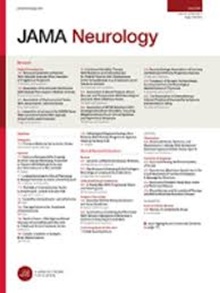轻度缺血性脑卒中患者的proro激酶与标准治疗:PUMICE随机临床试验
IF 20.4
1区 医学
Q1 CLINICAL NEUROLOGY
引用次数: 0
摘要
临床试验尚未证明阿替普酶或替尼替普酶在轻度卒中患者中优于标准治疗,并引起了安全性担忧。prorokinase是一种可替代的纤溶剂,可能具有良好的安全性,并且prorokinase在轻度卒中中的获益-风险概况尚不清楚。目的探讨普罗激酶在轻度缺血性脑卒中症状出现4.5 h内的疗效和安全性。设计、环境和参与者这是一项多中心、前瞻性、开放标签、盲终点随机临床试验,于2022年11月至2023年12月进行,随访3个月。该试验在中国89家医院进行。美国国立卫生研究院卒中量表(National Institutes of Health Stroke Scale)基线评分为5分或更低(评分范围从0-42分,分数越高表明神经功能缺陷越严重)的患者,在患者最后一次得知健康后的4.5小时内。排除有意进行血管内治疗的患者。干预:符合条件的患者按1:1的比例随机分配,接受35 mg (15 mg丸加20 mg输注超过30分钟)或标准治疗,包括抗血小板或抗凝治疗,由当地研究人员决定。主要结局和测量主要结局是在第90天修改后的Rankin量表得分为0或1(范围0-6,得分越高表明残疾程度越严重)。安全性结果为症状性颅内出血和死亡。结果3836例接受筛查的患者中,1446例(37.7%)入组试验。中位(IQR)年龄为65.9(57.7-72.7)岁,男性948例(65.5%)。共有723名患者被分配到尿激酶治疗组,723名患者被分配到标准治疗组。主要结局发生在尿激酶组639例(88.5%)和标准治疗组658例(91.0%)(相对危险度为0.97;95% ci, 0.94-1.01;双侧P = .12)。723例患者中有5例出现症状性颅内出血,使用激酶治疗为0.7%,标准治疗为0%,90天死亡率分别为2.3%和1.4%。结论和相关性这项随机临床试验的结果表明,在症状出现后4.5小时内,在改善轻度缺血性卒中患者的功能结局方面,prorokinase并不优于标准护理,但具有相似的安全性。临床试验注册号:NCT05507645。本文章由计算机程序翻译,如有差异,请以英文原文为准。
Prourokinase vs Standard Care for Patients With Mild Ischemic Stroke: The PUMICE Randomized Clinical Trial.
Importance
Trials have not demonstrated superiority of alteplase or tenecteplase vs standard care in patients with mild stroke and have raised safety concerns. Prourokinase is an alternative fibrinolytic that may have a favorable safety profile, and the benefit-risk profile of prourokinase in mild stroke is unknown.
Objective
To investigate the efficacy and safety of prourokinase in mild ischemic stroke within 4.5 hours of symptom onset.
Design, Setting, and Participants
This was a multicenter, prospective, open-label, blinded-end point randomized clinical trial conducted from November 2022 through December 2023 with 3 months of follow-up. The trial was conducted at 89 hospitals in China. Patients with a baseline National Institutes of Health Stroke Scale score of 5 or less (scores range from 0-42, with higher scores indicating more severe neurological deficit) within 4.5 hours from the time the patient was last known to be well. Patients with intention to proceed to endovascular treatment were excluded.
Interventions
Eligible patients were randomly assigned in a 1:1 ratio to receive prourokinase, 35 mg (15-mg bolus + 20-mg infusion over 30 minutes) or standard care, including antiplatelet or anticoagulant therapy, at the discretion of local investigators.
Main Outcomes and Measures
The primary outcome was modified Rankin Scale score of 0 or 1 (range, 0-6, with higher scores indicating greater disability) at day 90. Safety outcomes were symptomatic intracranial hemorrhage and death.
Results
Of 3836 patients who underwent screening, 1446 (37.7%) were enrolled in the trial. Median (IQR) age was 65.9 (57.7-72.7) years, and 948 were male (65.5%). A total of 723 patients were assigned to prourokinase and 723 to standard care. The primary outcome occurred in 639 patients (88.5%) in the prourokinase group and 658 (91.0%) in the standard care group (relative risk, 0.97; 95% CI, 0.94-1.01; 2-sided P = .12). Symptomatic intracranial hemorrhage was 0.7% (5 of 723 patients) with prourokinase and 0% with standard care, and mortality at 90 days was 2.3% and 1.4%, respectively.
Conclusions and Relevance
Results of this randomized clinical trial demonstrate that prourokinase was not superior to standard care to improve the functional outcomes for patients with mild ischemic stroke within 4.5 hours after symptom onset but had a similar safety profile.
Trial Registration
ClinicalTrials.gov Identifier: NCT05507645.
求助全文
通过发布文献求助,成功后即可免费获取论文全文。
去求助
来源期刊

JAMA neurology
CLINICAL NEUROLOGY-
CiteScore
41.90
自引率
1.70%
发文量
250
期刊介绍:
JAMA Neurology is an international peer-reviewed journal for physicians caring for people with neurologic disorders and those interested in the structure and function of the normal and diseased nervous system. The Archives of Neurology & Psychiatry began publication in 1919 and, in 1959, became 2 separate journals: Archives of Neurology and Archives of General Psychiatry. In 2013, their names changed to JAMA Neurology and JAMA Psychiatry, respectively. JAMA Neurology is a member of the JAMA Network, a consortium of peer-reviewed, general medical and specialty publications.
 求助内容:
求助内容: 应助结果提醒方式:
应助结果提醒方式:


